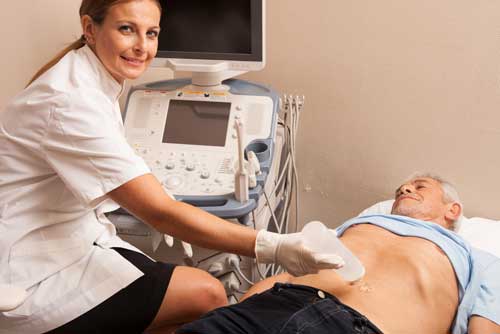Gallstones
Gallstones are solid build-ups of crystallized bile, which is produced by the liver, stored in the gallbladder and secreted into the bowel through the bile ducts to help digest fats. Some gallstones do not produce symptoms. However, they can cause a blockage within the bile duct or gallbladder which may result in pain and inflammation, a condition called cholecystitis.
Your doctor may use abdominal CT, magnetic resonance cholangiopancreatography (MRCP), or abdominal ultrasound to help diagnose your condition. Treatment may not be necessary if you do not have symptoms. If, however, you are diagnosed with cholecystitis, your doctor may prescribe antibiotics and surgical removal of the gallbladder. If a gallstone has blocked a bile duct, your doctor may prescribe biliary interventions such as endoscopic retrograde cholangiopancreatography (ERCP) or percutaneous transhepatic cholangiography (PTC) to locate and/or remove the blockage.
What are gallstones?
Gallstones are solid particles that develop in the gallbladder. Stones are formed from the crystallization of bile, a fluid made by the liver and secreted into the bowel through the bile ducts to help digest fats.
Some gallstones do not produce noticeable symptoms. However, if a gallstone causes blockage of the gallbladder or the bile duct, it can cause inflammation and pain in the right upper abdomen, upper right shoulder or between the shoulder blades, lasting from a few minutes to several hours. Other symptoms include nausea and vomiting, fever, and chills. Inflammation of the gallbladder is called cholecystitis.
How are gallstones diagnosed and evaluated?
Imaging is used to provide your doctor with valuable information about gallstones, such as location, size and effect on organ function. Some types of imaging that your doctor may order include:
- Abdominal ultrasound: Ultrasound produces pictures of the gallbladder and bile ducts. It shows signs of inflammation or indications that there is blockage of bile flow. Ultrasound is the most common test performed to evaluate gallbladder abnormalities.
For information about ultrasound procedures performed on children,
visit the Pediatric Abdominal Ultrasound page. - Abdominal CT: CT rapidly produces detailed pictures of the gallbladder and bile ducts to look for signs of inflammation or indications that there is blockage of bile flow. See the Safety page for more information about CT.
- Magnetic resonance cholangiopancreatography (MRCP): MRCP is an MRI exam that produces detailed images of the liver, gallbladder, bile ducts, pancreas and pancreatic duct. It identifies gallstones and can show gallbladder or bile duct inflammation or blockage. See the Magnetic Resonance Imaging (MRI) Safety page for more information.
How are gallstones treated?
Treatment of gallstones may not be necessary if you do not have symptoms. However, if you have cholecystitis, or if you are having symptoms related to gallstones, the standard treatment is intravenous antibiotics and surgical removal of the gallbladder (cholecystectomy). In most cases, your surgeon will perform a cholecystectomy laparoscopically (with endoscopes placed through small incisions in your abdomen).
If the gallstones have also caused blockage of the biliary ducts, other procedures may be performed, including:
- Endoscopic retrograde cholangiopancreatography (ERCP): ERCP is used to examine the bile ducts using an endoscope, a flexible tube that is passed from the mouth through the stomach and into the duodenum. Iodinated contrast material is injected into the bile ducts to locate gallstones that may be causing blockage. Some stones may be successfully removed during ERCP.
- Percutaneous transhepatic cholangiography (PTC): PTC is performed by making a small incision on the skin, and advancing a needle into the bile ducts. Iodinated contrast material is injected into the bile ducts to locate gallstones that may be causing blockage. Some stones can be removed during a PTC and others may be bypassed by leaving a catheter or small thin tube in place.
If your doctor decides that you are too sick to undergo surgery, there are other procedures that may be done until surgery can be performed.
- Cholecystostomy tube placement: A cholecystostomy tube is a small plastic tube (catheter) placed into your gallbladder through a small incision in the skin. The aim of this procedure is to decompress the distended, blocked and inflamed gallbladder by emptying out the backed up, under pressure bile in your gallbladder and diverting it outside the body into a bag attached to the tube. This allows decrease in pain and inflammation in the gallbladder and allows time for the antibiotics to work and for the surgery to be performed at a later date. However, it does not treat the underlying cause (the stones).
Which test procedure or treatment is best for me?
This page was reviewed on April 15, 2022



